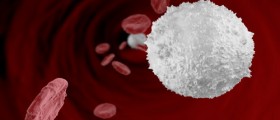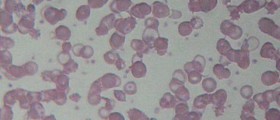
Polycythemia vera is a myeloproliferative disease in which the bone marrow produces too many erythrocytes (red blood cells). The excess of red blood cells leads to thickening of the blood and all the other symptoms and signs as well as complication of the condition. Primary polycythemia vera develops slowly and many patients remain asymptomatic for a long period of time. The condition is many times identified accidentally. Polycythemia vera is a serious medical condition and requires proper treatment. If left untreated, polycythemia vera may cause lethal outcome.
Clinical Characteristics of Polycythemia Vera
As it has already been mentioned polycythemia vera initially does not cause any symptoms or signs. However, progression of the disease is associated with headache, dizziness, itching skin (particularly after a warm bath or shower) and redness of the skin. In severe cases patients develop shortness of breath which is more intensive when an individual is lying down. Additional symptoms of polycythemia vera include numbness, tingling or burning sensation in the hands, feet or legs, muscle weakness and fatigue. The condition also leads to enlargement of the spleen and subsequent feeling of fullness in the upper left abdomen.
What Causes Polycythemia Vera?
Polycythemia vera develops as a result of gene mutation. This mutation affects bone marrow cells. In polycythemia vera the body loses control over production of red blood cells and their production by the bone marrow becomes excessive. It is estimated that majority of patients suffering from polycythemia vera actually have a specific mutation in the protein JAK2. Still, the experts have not managed to identify the underlying cause of the mutation yet.
Treatment for Polycythemia Vera
Polycythemia vera is not curable. However, it can be treated with several treatment modalities and brought under control. It is essential to start with the treatment as soon as the diagnosis is set.
Many patients suffering from polycythemia vera are treated with phlebotomy (taking blood out of the veins). By removing some of the blood the number of red blood cells decreases and the risk of potential complications reduces. The doctor decides when the procedure should be repeated. Furthermore, such patients may also undergo treatment with medications that decrease the number of blood cells. Some of these drugs include hydroxyurea and anagrelide. Another way to fight against excessive production of blood cells is to administer interferon-alpha. The risk of blood clots can be reduced with Aspirin and finally, itchy sensation can be overcome with the assistance of antihistamines and ultraviolet light treatment.
If left untreated polycythemia vera may cause many complications and thrombosis (blood clots), skin problems, peptic ulcers, gout and other blood disorders are only some of them.
- www.betterhealth.vic.gov.au/health/ConditionsAndTreatments/polycythaemia-vera
- www.nhs.uk/conditions/polycythaemia/
- Photo courtesy of The Armed Forces Institute of Pathology by Wikimedia Commons: commons.wikimedia.org/wiki/File:Polycythemia_vera,_blood_smear.jpg

















Your thoughts on this
Loading...